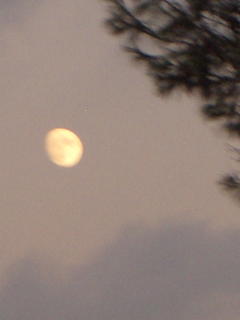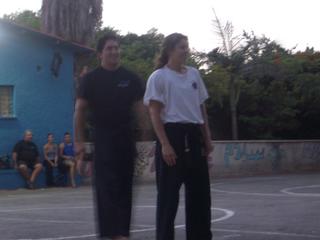
The moon in Israel is amazing. It is out in the early evening and it is very bright. On Saturday we just celebrated a holiday maybe comparable to Israeli Valentines Day. Here is a bit of history I found on the net. They only forgot to mention that the moon is full and a harvest type moon so it is so bright on this night.
The Mishna (Ta'anit 4:8), surprisingly enough, proclaims, "There were no greater holidays for Israel than Tu B'av and Yom Kippur, for on them the girls of Jerusalem used to go out in borrowed white dresses ... and dance in the vineyards. What would they say? 'Young man, lift up your eyes and see what you choose for yourself...' ".
Tu B'Av is a holiday devoted to singles. In earlier times the young single women would go out to the fields dressed in white. Each woman would wear a dress borrowed from another so that those who were too poor to have dresses of their own would not be shamed. Then the men would come down to the fields and pick a bride.
After the destruction of the temple and the exile of the Jewish people the holiday was rarely celebrated, but with the establishment of the modern state many Kibbutzim adopted the day as a sort of Jewish Valentine's day. People once again wore white and danced in the fields and the vineyards.
Throughout history many good things happened to the Jewish people on Tu B'Av. It was on Tu B'Av that the desert generation stopped dying in punishment for the sin of the spies. After King Solomon's death the Kingdom was split between Judea and Israel. The two
kingdoms were often at war with one another but it was on Tu B'Av that people from the northern kingdom were once again permitted to bring sacrifices to the Temple. It was on Tu B'Av after the Bar Kochba Revolt that the Jews were finally permitted to bury their dead.
Tu B'Av is also a day on which a number of restrictions on women were lifted. Though usually the separation between men and women was closely guarded, on Tu B'Av men and women were allowed to intermingle freely. Women were not forced to hide themselves away, to cover themselves to avoid attracting (and distracting) men. This was a day for flirting and attraction. The women's own innate sense of modesty was enough and did not require additional external reinforcement.
In the Torah, at the request of the daughters of Zelapachad women were given some inheritance rights, but only on the condition that they did not marry outside their tribe. This restriction was lifted on Tu B'Av after which women were permitted to marry whomever they wished.
In the time of the Judges there was a civil war between the tribes. The women of the other tribes were forbidden from marrying into the tribe of Benjamin. This restriction too was lifted in Tu B'Av. In both these two cases, as well as lifting restrictions on women, Tu B'Av was a day when the tribes were reunified.
Tu B'Av (15th Av) comes less than a week after Tisha B'av (9th Av), the day that commemorates the destruction of the Temple. The destruction of the Temple was the lowest point in Jewish history, but with Tu B'Av we pick ourselves up and go on again. Tu B'Av is about hope and continuity even after the worst of things. It is about getting on with life, and with love.


Ti-ul is a trip in Hebrew. We went on out first last week to the Plasson factory. This factory is on my Kibbutz and basically is what makes my kibbutz so rich. I like factory tours. It is interesting to see how things are made. Plasson makes products that deal with water, such as toilet tanks, chicken and turkey watering systems and pipes.


Also last week we saw a demonstration of Karv Maga. It was really cool to see it done and very interesting to watch a girl kick this guys butt. Here is another explaination:
(krav-ma•ga) pronounced (kräv) (megä´) n. [Hebrew.] for “contact combat”, is the official self-defense and hand-to-hand combat system of Israel. Krav Maga is a very modern and practical style of self-defense that is the only style worldwide known as an art of self-defense and not as a martial art. Krav Maga isn't about being a tough guy, it's not about learning how to fight in a ring, it's about going home alive no matter what the situation. Krav Maga is a survival system dealing with personal safety issues in the context of defending against both armed and unarmed attackers. Krav Maga integrates instinct based self-defense tactics, with a strong curriculum that trains aggressiveness, fighting spirit, situational awareness, and verbal de-escalation of conflict. Its anti-terrorist roots make it aggressive by design, with only one objective, to eliminate the threat in the fastest way possible. It is considered a highly refined, street fighting system, designed to be utilized against street attacks, muggings, and sexual assaults. Krav Maga was developed for use in the street. When an individual is attacked in the street there is no way to know how many opponents or weapons you might encounter, therefore Krav Maga training is based on a system without rules. This Israeli system emerged in an environment where extreme violence was common has been continually refined and developed in light of actual modern combat and self-defense experiences. Krav Maga has received international recognition for its unique approach in bringing self defense to civilian, military, and law enforcement alike. The Krav Maga symbol consists of the Hebrew letters K and M surrounded by an open circle because the system is open to improvement by adding techniques, exercises, and training methods.

No comments:
Post a Comment